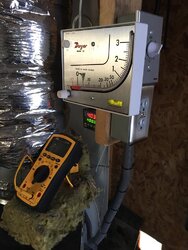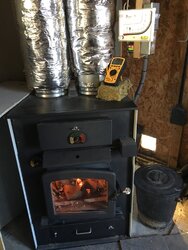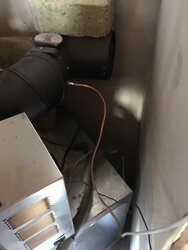All I know is that I'm ready for the "warm up" tomorrow - a high of 41°F, I haven't cleaned the stove out in a week and have a huge load of ashes to shovel out - probably 2" above the bottom of the door at this point. I have been going through the wood the last week or so.. I just reloaded my basement "wood room" Saturday with some 1 year old ash, although it is not as dry as it should be. Even with the dry ash before it, with the 0-10°F outside temps, the best I could do was about 70°F indoor temps, maybe as high as 72, and dropping into the mid 60's if I raked the coals and tried to let them burn down more before reloading. The house had a chill if I tried to go 10 hours on a load so I was doing smaller loads at 6-8 hours.
I mean I'm still happy because I never used the LP furnace but I feel there's still some heat to gain out of this Tundra. I need to make a few more improvements on my duct system for sure.
I especially like leaving a gap in the wood, at least toward the front, for the boost air nozzle (bottom, front and center...which I make sure is cleared off on every load) to be able to blow on the coals that I just raked up for the reload.
Stupid question #1: I know where the boost air nozzle is on the outside of the stove, but where does it go into the fire box at? It doesn't appear to go straight through into the fire box. I have felt around before and not found that boost air hole in the firebox, and with the amount of ashes I have right now, I guarantee that it is blocked.
2. Is there any maintenance regarding the secondary burn tubes? On some good dry ash late last week, I watched the stove and did not get a good secondary burn. The middle burner was burning the full width, the front did not light off at all, and the rear was flashing flames on and off. I expected a much better secondary burn, and have previously had a much better secondary burn. If I bumped these tubes with a piece of wood, can they become unseated? Or is it more likely that they need cleaned, or that my temperature set points are not ideal?
I will post a picture of my setup, but essentially, my thermocouple and manometer are tapped almost right off the back of the stove. Out the back of the stove, I have a 90° elbow, then my barometer. The TC and manometer are essentially at the joint between the barometer and the elbow - so before the barometer. I vary my low alarm set point, right now it is 255°F and I believe my alarm hysteresis is 150°. I want to keep the stove running a little hotter, just due to the wood not being as dry as possible, my thought being the higher temps should help with reducing creosote or condensation - at the expense of burn time, which is an acceptable trade-off.




 I heard this in the back of my head and did it a few times reminding my self when I came home why this was not all that effective. Wind up with way to many coals insulated by way too much ash.
I heard this in the back of my head and did it a few times reminding my self when I came home why this was not all that effective. Wind up with way to many coals insulated by way too much ash.